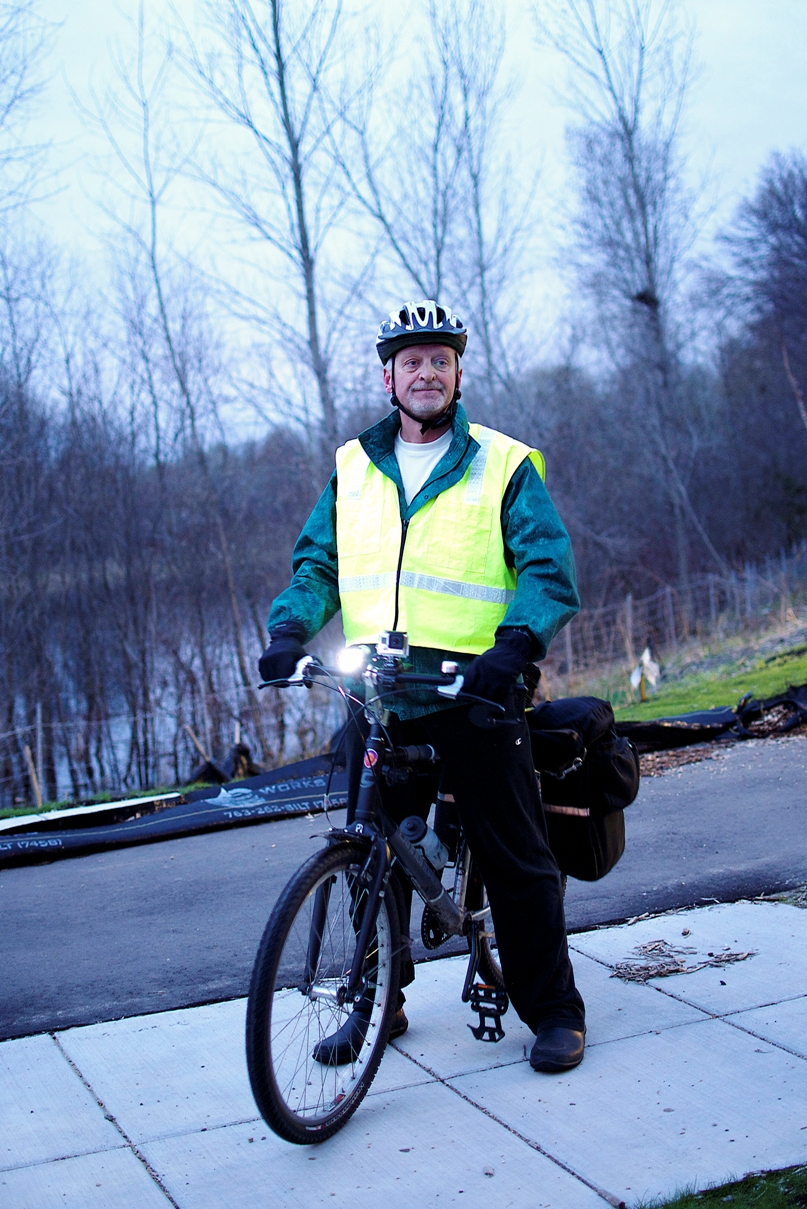 When Mike Bastyr started working in downtown Minneapolis more than 20 years ago, he quickly grew tired of battling traffic on Interstate 35W. To circumvent the stress, he turned to Route 250, an express service that runs between Lino Lakes and Minneapolis.
When Mike Bastyr started working in downtown Minneapolis more than 20 years ago, he quickly grew tired of battling traffic on Interstate 35W. To circumvent the stress, he turned to Route 250, an express service that runs between Lino Lakes and Minneapolis.
Not long after he started commuting by bus, Bastyr went a step further and began to bike the six miles that separated his Shoreview home from his boarding location, the County Road H Park & Ride in Mounds View.
The half-hour bike trip finds him on quiet residential streets and the Rice Creek North Regional Trail, a wooded area he describes as “very serene.” The trail cuts through woodlands and connects to County Road H just west of I-35W.
“There’s a lot of wildlife,” Bastyr said after completing a recent ride. “This morning it was two deer. Last week it was a fox, an osprey and an eagle. It’s just a really pleasant experience no matter what time it is.”
After maintaining the routine year-round since 2000, Bastyr believes he’s logged an estimated 26,000 miles traveling between his home and the Park & Ride. Avoiding gas fill-ups and using an employer-subsidized Metropass, he has also saved untold amounts of money. Bastyr's commuting costs are less than $50 a month.
“This bike has paid for itself a few times over,” he joked.
Bastyr’s commute provides a good example of how biking and transit can be combined, even in suburban areas. There are 15 Metro Transit Park & Rides with bike lockers – secure, weatherproof storage areas that rent for $48 a year, with a refundable damage deposit. Bike lockers are also located at select Northstar and METRO Blue Line stations.
For those who want to bring the bike along, buses are equipped with front-end racks; bikes can be brought directly on board Northstar and light-rail trains.
As part of Bike Week, Metro Transit offered free rides to customers who biked to select Park & Rides and completed their trip on a bus or train. The Minneapolis Bicycle Coalition also offered free ride coupons to bicyclists at the Blue Line's 38th Street Station and at the corner of East Lake and West River roads.
Long-term, the Metropolitan Council wants to strengthen the link between biking and taking transit by prioritizing regional on- and off-road investments that would better connect cyclists to the regional transit system.
A recently-completed Regional Bicycle System Study, developed with the Minnesota Department of Transportation, provides a Regional Transportation Network for developing such connections in the future. The proposed network will be incorporated in the Met Council’s draft 2040 Transportation Policy Plan, which will be be distributed for public review this summer.
While it’s difficult to know exactly how many people combine biking and transit, there is ample evidence that more people are biking and taking transit in the Twin Cities. The number of bicyclists counted in Bike Walk Twin Cities’ annual survey increased 78 percent between 2007 and 2013. More than 4 percent of Minneapolis residents bike to work, one of the highest rates in the country, according to the U.S. Census.
Metro Transit’s ridership increased by more than 300,000 rides between 2012 and 2013 and is at the highest level in three decades.
Shirley Urman, of Mounds View, is among those who are combining biking and transit.
The 17-year-old began riding to the County Road H Park & Ride earlier this year when she started taking classes at Perpich Center for Arts Education in Golden Valley. Urman brings her bike to Minneapolis so she can ride to her transfer bus, Route 755, and enjoy a leisurely ride after school in nearby Theodore Wirth Regional Park.
Besides giving her more flexibility to get around, Urman said riding her bike to the Park & Ride each morning gives her the boost she needs to start her day.
“I was really tired and wouldn’t want to go to school, but once I had exercise in the morning I was pumped for my day,” she said, traveling in on Route 250. “I just kept doing it and now it’s a habit.”
Bastyr hopes he and Urman will be joined by even more bikers in the future. Bastyr’s best advice to those who want to make biking a part of their commute is to start slowly, riding only as much as comfortable and ramping up as confidence and enthusiasm builds.
“After a while it becomes a routine,” he said. “That’s what it’s developed into for me – a routine experience where instead of getting in your car and driving some place you hop on your bike and pedal instead.”
> Park & Ride Search
> Bike Lockers
> Regional Bicycle System Study
> Biking to work increases 60 percent over last decade, Census Bureau reports